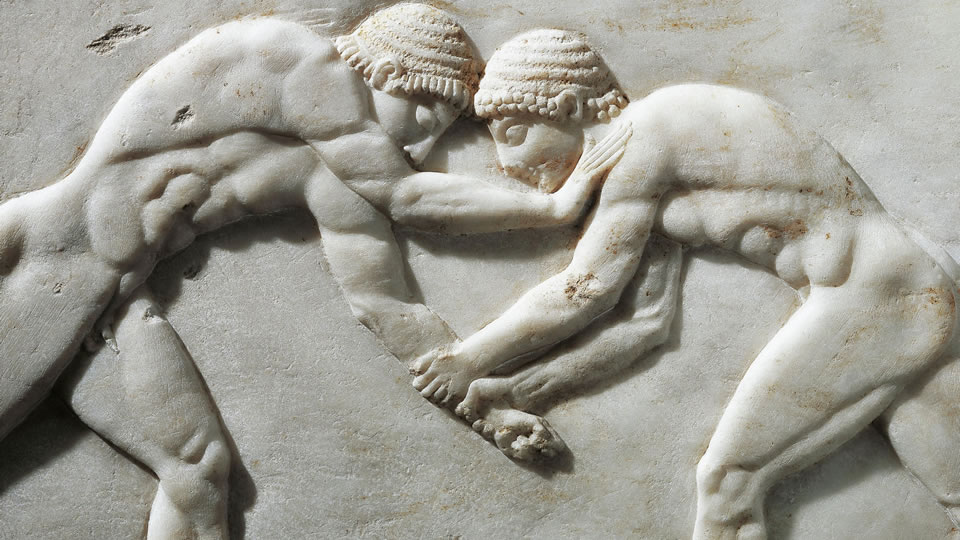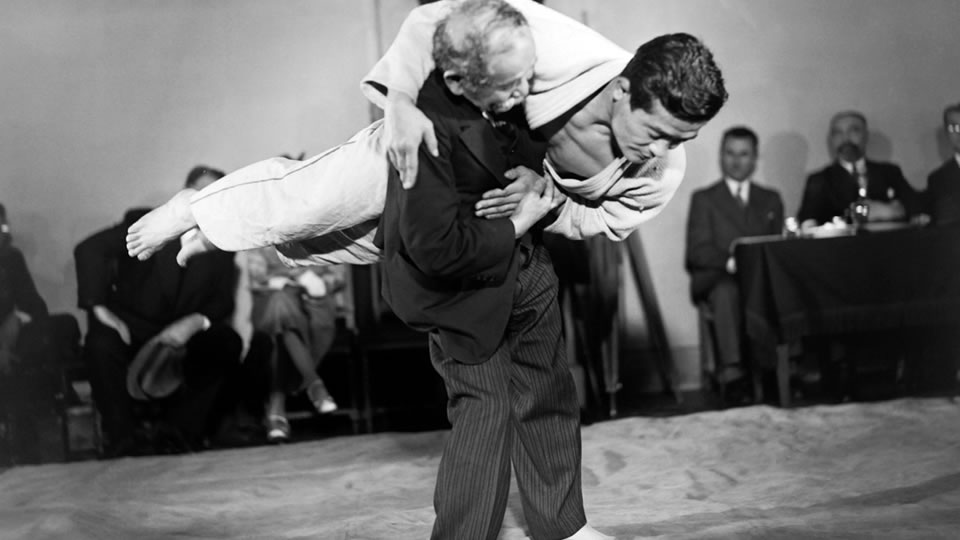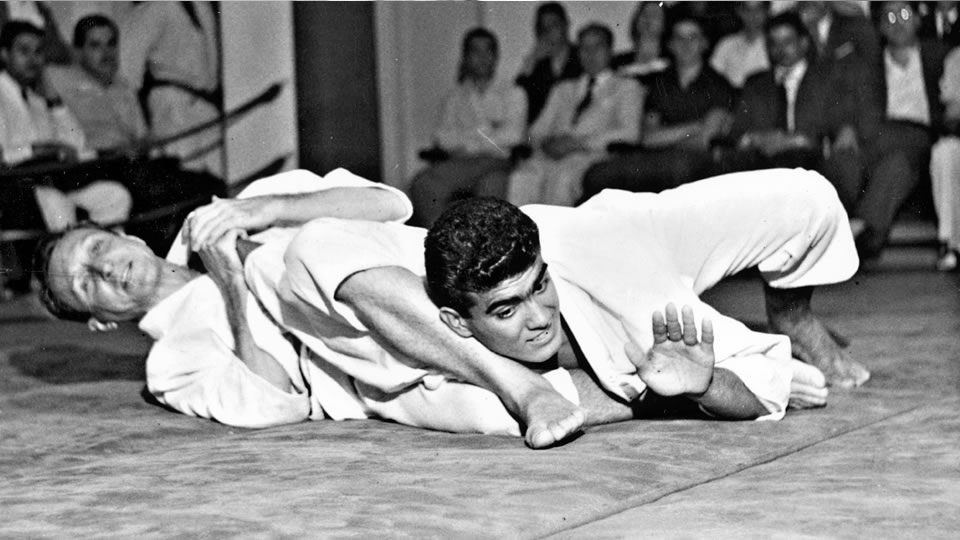
Wrestling represents one of the oldest forms of combat. The origins of wrestling go back 15,000 years through cave drawings in France.
Babylonian and Egyptian reliefs show wrestlers using most of the holds known in the present-day sport. Literary references to it occur as early as in the ancient Indian Vedas. The Iliad contains references, in which Homer recounts the Trojan War of the 13th or 12th century BC Indian epics Ramayana and Mahabharata contain references to martial arts including wrestling. In ancient Greece wrestling occupied a prominent place in legend and literature; wrestling competition, brutal in many aspects, served as the focal sport of the ancient Olympic Games.
Jiu Jitsu India

Buddhist monks were the creators of the most complete form of personal defense of all times, which was jiu-jitsu, the father of all fights. Among his followers, monks in far away monasteries who were obliged to travel through the interior of India, and had to defend against the attacks of bandits who infested the region, there were some who were the real creators of this kind of fight that allowed self-defense without using weapons that would violate the morals of the religion. In this way was born the jiu-jitsu with the spirit of defense that is its fundamental element. The application of physical laws, such as leverage, momentum, equilibrium, center of gravity, and a detailed study of the vital points of the human body, allowed them to create the art of scientific fighting
Jiu Jitsu Japan

Jujutsu first began during the Sengoku period of the Muromachi period combining various Japanese martial arts which were used on the battlefield for close combat in situations where weapons were ineffective. In contrast to the neighbouring nations of China and Okinawa whose martial arts were centered around striking techniques, Japanese hand-to-hand combat forms focused heavily upon throwing, immobilizing, joint locks and choking as striking techniques were ineffective towards someone wearing armor on the battlefield During this new ideology weapons and armor became unused decorative items, so hand-tohand combat flourished as a form of self-defense and new techniques were created to adapt to the changing situation of unarmored opponents. This included the development of various striking techniques in jujutsu which expanded upon the limited striking previously found in jujutsu which targeted vital areas above the shoulders such as the eyes, throat, and back of the neck. However towards the 18th century the number of striking techniques was severely reduced as they were considered less effective and exert too much energy; instead striking in jujutsu primarily became used as a way to distract the opponent or to unbalance him in the lead up to a joint lock, strangle or throw.
During the same period the numerous jujutsu schools would challenge each other to duels which became a popular pastime for warriors under a peaceful unified government, from these challenges randori was created to practice without risk of breaking the law and the various styles of each school evolved from combating each other without intention to kill.
Kano Jiu Jitsu

Jigoro Kano (1860-1938), member of the Japanese Ministry of Culture and Martial Artist, played an important role in rescuing Jiu-Jitsu reputation in times of peace.
When Kano attended the Tokyo Imperial University in 1877, he started looking for jiu-jitsu teachers. He first looked for bonesetters, called seifu kushi. His assumption was that doctors knew who the better martial art teachers were. His search brought him to Yagi Teinosuke, who had been a student of Emon Isomata in the Tenjin Shin school of jiu-jitsu. Yagi, in turn, referred Kano to Fukuda Hachinosuke, a bonesetter who taught Tenjin Shin in a 10-mat room adjacent to his practice. Tenjin Shin was itself a combination of two older schools: the shin-ry and Shin no Shin.
Fukuda training method consisted mostly of the student taking fall after fall for the teacher or senior student until he began to understand the mechanics of the technique. Fukuda stressed applied technique over ritual form. He gave beginners a short description of the technique and had them engage in free practice (randori) in order to teach through experience. It was only after the student had attained some proficiency that he taught them traditional forms (kata). This method was difficult, as there were no special mats for falling, only the standard straw mats (tatami) laid over wooden floors.
Kano had trouble defeating Fukushima Kanekichi, who was one of his seniors at the school. Therefore, Kano started trying unfamiliar techniques on his rival. He first tried techniques from sumo. When these did not help, he studied more, and tried a technique firemans carry that he learned from a book on western wrestling. This worked, and kataguruma, or shoulder wheel, remains part of the judo repertoire, although at this moment the judo organizations of some countries prohibit this throw in competition judo On 5 August 1879, Kano participated in a jiu-jitsu demonstration given for former United States president Ulysses S. Grant. This demonstration took place at the home of the prominent businessman Shibusawa Eiichi.
1914 Jiu-Jitsu arrives in Brazil Maeda meets Gracie

Count Koma A champion in his own right and student of Jigoro Kano, Maeda began his travels abroad with a group of men who participated in challenge matches across the globe. In 1914 he landed in the northern state of Para, Brazil, to help establish the Japanese colony in that region. Settling down in Belem do Para, it was natural for Maeda to make use of his outstanding fighting skills in demonstrations, shows, and even circuses as a way to make a living and spread the Japanese Culture.
The first time Carlos Gracie met Count Koma, was at one of these demonstrations. Carlos was amazed by Komas ability to defeat other opponents who were much bigger and stronger than him.
Carlos Gracie was a wild kid who was slipping out of control and away from his father, Gastao and mother, Cesalina. Energetic and rebellious, Carlos was giving them a lot of trouble. Knowing that Maeda just started a Jiu-Jitsu program in town, Gastao decided to take Carlos there to learn from the Japanese as a way to calm down and discipline his son.
1916 – Carlos Gracie
Mitsuyu Maeda introduced Carlos to Jiu-Jitsu, at the age of 14. He became an avid student for a few years. The studies under Maeda had a profound impact on his mind. He never before sensed the level of self-control and self-confidence Jiu- Jitsu practice allowed him to experience.
The connection he felt with his body in each training session allowed Carlos to gain a deeper understanding about his nature, limitations, and strengths, and brought him a sense of peace that he never felt before in his life. The times with Maeda did not last for long, though. Less then 5 years from the day he started, Carlos had to move to Rio de Janeiro with his parents and siblings.
Arriving at the then capital of Brazil at the age of 20, Carlos Gracie had difficulties adapting to a normal life and working at a regular job. Even though he worked in overnmental institutions, Carlos’ wild spirit would not allow him to settle down. His desire to teach the art he learned from Maeda was already burning and he decided to go after it.
The profession of Martial Arts instructor at the beginning of the 20th century in Brazil was not exactly the most promising. People’s awareness about it was practically nonexistent, making it really hard to find students who would be willing to pay a tuition in exchange for instruction.
The only people to see value in what Carlos Gracie had to teach were Law Enforcement officials. An opportunity finally arose for Carlos to teach outside of Rio de Janeiro, in the state of Minas Gerais.
The passion for Jiu-Jitsu and Koma’s dedication to make him a Champion, allowed Carlos to discover a new meaning in his life. From then on, Carlos started to use and see Jiu-Jitsu as a tool to help him find his way through the world. More than that, with time, he elected Jiu-Jitsu as an ideal worth fighting for and embraced it with strength and determination.
Reila Gracie had good opportunities to make a living. After a few years in Minas, Carlos decided to move to Sao Paulo and then back to Rio. His free spirit and faith in the great things Jiu-Jitsu could do for common people seemed to have made it hard for him to restrict his teachings to police officers and members of law enforcement agencies.
1925 – The First Gracie School is Founded – the Gracie Clan
The first Gracie Brazilian Jiu-Jitsu School was founded in 1925 at Rua Marquês de Abrantes 106, Rio de Janeiro, Brazil. At the age of 23 years old, Carlos Gracie understood well the amazing benefits Jiu-Jitsu could bring to one’s life. Founding a school represented a very important milestone in his decision to grow Jiu-Jitsu Gracie as a national sport in Brazil.
The Marquês de Abrantes school was not exactly what one would expect as the pioneer power house of Gracie Brazilian Jiu-Jitsu. With limited resources and concerned with the well being of his younger brothers, all Carlos could afford was a small house where he turned the living room into a training area.
In that house Carlos united his brothers and engaged them in his life project. He knew it would be impossible to accomplish such a gigantic task alone and started to teach his younger brothers, Oswaldo (1904), Gastao (1906), George (1911), and Helio (1913). The first generation of Gracie brothers living and working in the same house seems to have forged the family spirit that flowed down through generations and was so important to the extraordinary success the Gracie Family achieved over the years.